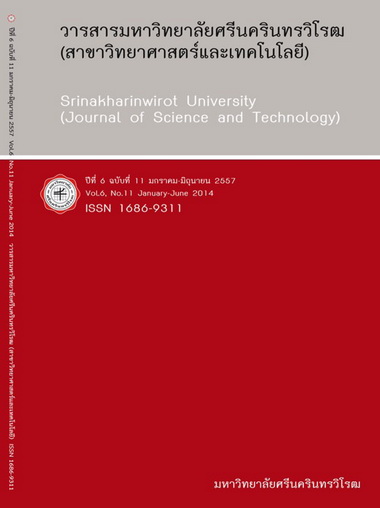ภาวะสุขภาพจิตและปัจจัยที่สัมพันธ์ในนิสิตทันตแพทย์มหาวิทยาลัย ศรีนครินทรวิโรฒ MENTAL HEALTH AND ASSOCIATED FACTORS IN SRINAKHARINWIROT UNIVERSITY DENTAL STUDENTS
Keywords:
Dental students, Mental health, GHQ-12Abstract
บทคัดย่อ
การศึกษานี้เป็นการศึกษาภาวะสุขภาพจิต และปัจจัยที่สัมพันธ์กับสุขภาพจิตของนิสิตทันตแพทย์ มหาวิทยาลัยศรีนครินทรวิโรฒ โดยเป็นการศึกษาแบบสำ รวจภาคตัดขวางเก็บข้อมูลจากนิสิต คณะทันตแพทยศาสตร์ มหาวิทยาลัยศรีนครินทรวิโรฒทุกคน ชั้นปีที่ 1-6 ในช่วงเดือนธันวาคม พ.ศ. 2554 ถึง เดือนมกราคม พ.ศ. 2555 โดยใช้แบบสอบถามข้อมูลประชากรศาสตร์ และแบบวัดประเมินสุขภาพทั่วไป ฉบับภาษาไทย (Thai General Health Questionnaire-12; จีเอชคิว-12) วิเคราะห์ความสัมพันธ์ของตัวแปรโดยใช้สถิติไคสแควร์ และใช้สถิติวิเคราะห์การถดถอย จากผลการศึกษามีผู้ตอบแบบสอบถามครบถ้วนสมบูรณ์ 287 คน คิดเป็นร้อยละ 78.6 จากจำนวนนิสิตทั้งหมด 365 คน พบว่า มีนิสิตทันตแพทย์ จำนวน 107 คน (ร้อยละ 37.3) มีคะแนน จีเอชคิว-12 มากกว่า 2 ซึ่งจัดว่าเป็นกลุ่มที่มีโอกาส
มีปัญหาสุขภาพจิต จากการทดสอบความสัมพันธ์ด้วยสถิติวิเคราะห์พหุตัวแปร พบว่าปัจจัยที่มีความสัมพันธ์ต่อการมีปัญหาสุขภาพจิตอย่างมีนัยสำคัญทางสถิติ คือ เพศ ชั้นปี และภูมิลำเนา ทั้งนี้ นิสิตทันตแพทย์เพศหญิงมีโอกาสมีปัญหาสุขภาพจิตเป็น 1.82 เท่าของนิสิตทันตแพทย์เพศชาย และนิสิตทันตแพทย์ชั้นคลินิก (ปีที่ 4-6) มีโอกาสมีปัญหาสุขภาพจิตเป็น 4.41 เท่าของนิสิตทันตแพทย์ชั้นพรีคลินิก(ปีที่1-3) และนิสิตทันตแพทย์ที่มีภูมิลำเนาอยู่ในชนบทมีโอกาสมีปัญหาสุขภาพจิตเป็น 2.12 เท่าของนิสิตทันตแพทย์ที่มีภูมิลำเนาอยู่ในกรุงเทพมหานคร ซึ่งสรุปได้ว่า เพศ ชั้นปี และภูมิลำเนา เป็นปัจจัยที่มีความสัมพันธ์กับโอกาสมีปัญหาสุขภาพจิตของนิสิตทันตแพทย์
Abstract
The objectives of this study were to evaluate the mental health and associated factors of dental students of Srinakharinwirot University. The study was a cross-sectional survey study. The sample included all 1st-6th year dental students of the Faculty of Dentistry, Srinakharinwirot University during December 2011 to January 2012. All dental students were invited to complete the questionnaire for demographic data, and the Thai General Health Questionnaire 12
(Thai GHQ-12). Mean, percentage, Chi-square and logistic regression were used to analyze the data. The Results showed that, there were 287 dental students (78.6%) who completed the questionnaire. 107 (37.3%) of the dental students had a Thai GHQ-12 score more than
2 which indicate chance of mental health problem. Multivariate analysis revealed three factors significantly associated with the students’ mental health: gender, dental class, and domicile. Female dental students had a 1.82 times higher risk of mental health problems than males. The Clinical dental students (4th-6th year) were 4.41 times more likely to have mental health problems than Pre-Clinical dental students (1st-3rd year). Dental students from rural areas were
2.12 times more likely to suffer mental health problems than the dental students from Bangkok. The three factors that were significantly associated with the risk of mental health problems in dental students were gender, dental class, and domicile
Downloads
Downloads
Published
How to Cite
Issue
Section
License
Srinakharinwirot University Journal of Sciences and Technology is licensed Under a Creative Commons Attribution-NonCommercial-NoDerivs 4.0 International (CC-BY-NC-ND 4.0) License, Unless Otherwise Stated. Please Read Journal Policies Page for More Information on Open Access, Copyright and Permissions.


